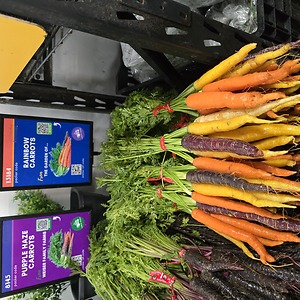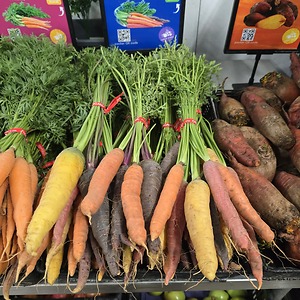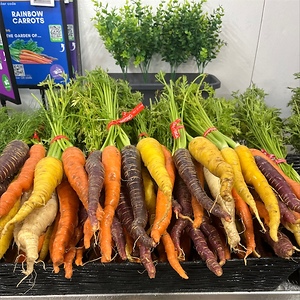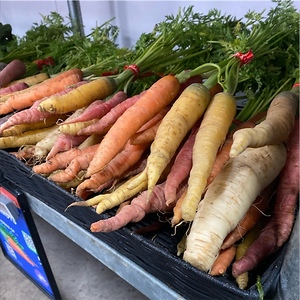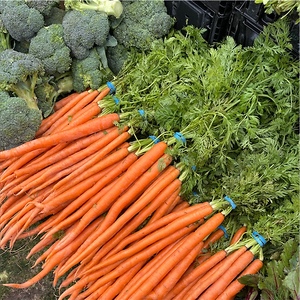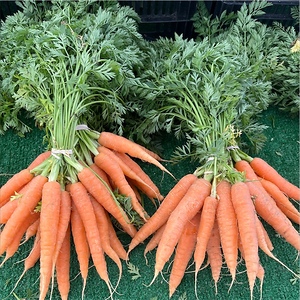


Carrots
Estimated Inventory, 25 lbs : 28.44
This item was last sold on : 06/30/25
Description/Taste
Carrots, depending on the variety, can range in size from small to large and typically average 10-25 centimeters in length. The roots have an elongated, slender shape that can be conical, cylindrical, or slightly irregular depending on growing conditions and the individual cultivar. The skin is smooth, firm, covered in tiny root hairs, and ranges in color from shades of orange, yellow, purple, black, red, to white. Underneath the surface, the flesh generally matches the skin color and is dense, crisp, and slightly aqueous with a snap-like quality. Carrots are crunchy when raw with a sweet or bitter, earthy flavor, and the leaves are also edible with an herbaceous, parsley-like taste.
Seasons/Availability
Carrots are available year-round, with peak seasons in the spring and winter.
Current Facts
Carrots, botanically classified as Daucus carota subs. sativus, are slender, edible, underground taproots that grow frilly leaves in a rosette pattern and belong to the Apiaceae family along with celery, parsnips, and parsley. Labeled as a root vegetable, there are many different varieties of Carrots found in a wide array of colors that are harvested at multiple stages of maturity for commercial sale. Carrots have been cultivated since ancient times and were deeply rooted in the diets and traditional medicine of Asian and European cultures. Despite our familiarity today with the bright orange variety, orange carrots did not arrive into the commercial marketplace until the 16th and 17th centuries. There are two descriptors used to define the root’s origins that are labeled as Eastern and Western. Eastern carrots include many of the red, black, and purple varieties, while Western carrots include yellow, white, and orange varieties.
Nutritional Value
Carrots are an excellent source of vitamin A, which can help prevent vision loss, vitamin C to protect the body from sickness, and fiber to assist with digestion. The roots also contain some vitamin K, magnesium, calcium, folate, and potassium.
Applications
Carrots are one of the most versatile and fundamental ingredients in culinary recipes, used in raw and cooked form for both sweet and savory recipes. When raw, Carrots can be consumed fresh as a snack dipped into hummus or dressings, shredded into salads, or juiced for a healthy beverage. The roots can also be shredded into coleslaws, sandwiches, wraps, scallion pancakes, and baked goods. In cooked preparations, Carrots can be roasted with other winter root vegetables as a caramelized side dish, boiled for a soft and tender consistency, cooked and blended into natural baby food, or pickled for use as a condiment, especially in Vietnamese cuisine. Carrots pair well with almonds, bacon, butter, celery, cheeses such as cheddar, parmesan and pecorino, cinnamon, cream, ginger, parsley, potatoes, mushrooms, shallots, tomatoes, and red or white wine vinegar. The roots will keep up to one month when stored in a slightly opened plastic bag to allow for air circulation in the crisper drawer of the refrigerator.
Ethnic/Cultural Info
Carrots are famously used in French mirepoix, which is a combination of onions, carrots, and celery used to add subtle flavors to dishes. Traditionally made up of fifty percent onions, twenty-five percent Carrots, and twenty-five percent celery, mirepoix was created in the early 1800s and was used to flavor broths. Mirepoix has increased in popularity across the world and is used in many different cuisines as a base for stocks, soups, and stews. This combination utilizes Carrots for their sweet flavor and celery and onions for their mild, savory flavor and aromatics.
Geography/History
Carrots originated over five thousand years ago in present-day Afghanistan in Asia. As the roots were domesticated, natural hybrids and mutants were developed and crossed with wild and cultivated varieties creating new cultivars varying in color, size, and flavor. Carrots were then transported via seeds across Africa, Europe, and Eastern Asia and were sold during trade expeditions. Orange carrots first appeared in Europe in the 16th and 17th centuries, quickly displacing other varieties and dominating the market. Today many heirloom varieties and orange carrots can be found at local farmers markets, specialty grocers, and in home gardens in North America, South America, Africa, Europe, Asia, and Australia.
Featured Restaurants
Restaurants currently purchasing this product as an ingredient for their menu.
| Bea Green Cold Pressed Juice | Alpine CA | 619-398-6295 |
| Menya Ultra (Mira Mesa) | San Diego CA | 619-889-4566 |
| Single Fin Surf Grill | San Diego CA | 619-948-7873 |
| Cody's La Jolla | La Jolla CA | 858-459-0040 |
| Starlite Kitchen | San Diego CA | 619-358-9766 |
| Chef Sebastian LLC | La Jolla CA | 858-740-0878 |
| Yoann Taboyan, Personal Chef | San Diego CA | 347-277-1958 |
| Belmont Park Draft | San Diego CA | 858-228-9283 |
| Relic Bageri LLC | San Diego CA | 619-335-6328 |
| Merenda | Oceanside CA | 703-459-4145 |
| Vista Valley | Vista CA | 760-758-2800 |
| Coral Del Mar | Del Mar CA | 858-449-6679 |
| Bar Ella | San Diego CA | 858-808-2286 |
| The Crack Shack Costa Mesa | Costa Mesa CA | 951-808-7790 |
| Convention Center Shell | San Diego CA | 619-954-3063 |
| Wildland Bar | Carlsbad CA | 619-385-0914 |
| Trust Restaurant | San Diego CA | 609-780-7572 |
| Lilo | Carlsbad CA | 619-385-0914 |
| Bayhill Tavern | San Diego CA | 858-288-6923 |
| Craft House Sky Deck | San Diego CA | 619-948-4458 |
| Brigantine Del Mar | Del Mar CA | 858-481-1166 |
| Flora Cafe | Bonita CA | 619-339-6604 |
| Rosewood Social | San Juan Capistrano CA | 669-243-8403 |
| Sabi Juice | Chula Vista CA | 619-971-8545 |
| The Britannia Tearooms | San Diego CA | 619-683-2748 |
| Firefly Beach | San Diego CA | 619-222-6440 |
| Whiskey Girl | San Diego CA | 619-236-1616 |
| Belching Beaver Brewery Tavern and Grill | Vista CA | 760-509-4424 |
| Brigantine Escondido | Escondido CA | 760-743-4718 |
| Redwing Bar & Grill | San Diego CA | 619-281-8700 |
| Waverly | Cardiff CA | 619-244-0416 |
| The Crossings | Carlsbad CA | 760-444-1800 |
| Happy Medium SD | San Diego CA | 509-869-2279 |
| 619 Spirits | San Diego CA | 509-701-9534 |
| Rabbit Hole | San Diego CA | 619-255-4653 |
| The Country Club Of Rancho Bernardo | San Diego CA | 858-487-1134 |
| Gold Finch | San Diego CA | 619-804-2051 |
| Bridges at Rancho Santa Fe | Rancho Santa Fe CA | 858-759-6063 |
| Village Pizzeria Bay Side | Coronado CA | 619-522-6890 |
| Harumama Noodles & Buns (Encinitas) | Encinitas CA | 858-886-9909 |
| Tahona (Bar) | San Diego CA | 619-573-0289 |
| Leu Leu | Leucadia CA | 619-316-5807 |
| JRDN Restaurant | San Diego CA | 858-270-5736 |
| The Cottage Encinitas | Encinitas CA | 858-454-8409 |
| Sushi Ota 2021 | San Diego CA | 858-270-5047 |
| The Santaluz Club Inc - Banquet | San Diego CA | 858-759-3150 |
| Royal Polaris Sportfishing | San Diego CA | 619-226-8030 |
| Ketch Grill and Taps | San Diego CA | 858-268-1030 |
| Noble House Hotels & Resorts | San Diego CA | 619-276-4010 |
| Lodge at Torrey Pines Main | San Diego CA | 858-453-4420 |
| Mariahs Westwind Restaurant | San Marcos CA | 760-736-8108 |
| Marriott Courtyard Nolen | San Diego CA | 619-544-1004 |
| El Sueno | San Diego CA | 619-972-6286 |
| Georges at the Cove | San Diego CA | 858-454-4244 |
| The Cottage | La Jolla CA | 858-454-8408 |
| Herb & Sea | Encinitas CA | 858-587-6601 |
| Dot to Dot Academy | San Diego CA | 858-485-1978 |
| Sepulveda Meats & Provisions | San Diego CA | 619-501-1878 |
| Coin-Op Game Room (Downtown) | San Diego CA | 619-255-8864 |
| Sbicca Del Mar | Del Mar CA | 619-417-2587 |
| Huntress | San Diego CA | 619-955-5750 |
| Shimbashi Izakaya | Del Mar CA | 858-523-0479 |
| Crust Pizzeria Solana Beach | Solana Beach CA | 858-212-8751 |
| Pier 32 Water Front Grill | National City CA | 619-718-6240 |
| Knotty Barrel- Rancho | San Diego CA | 858-484-8758 |
| Harney Poway Sushi | Poway CA | 760-533-0051 |
| Comma | San Diego CA | 619-802-9183 |
| Kensington Cafe | San Diego CA | 619-684-0044 Fausto |
| Harney Sushi | San Diego CA | 619-295-3272 |
| Poseidon on the Beach | Del Mar CA | 858-755-9345 |
| Candor | La Jolla CA | 858-581-2205 |
| Il Giardino di Lilli | La Jolla CA | 619-467-9897 |
| Nadolife Production | San Diego CA | 619-239-1224 |
| Oscars Brewing Company | Temecula CA | 619-695-2422 |
| The Crack Shack-Encinitas | Encinitas CA | 877-230-1871 |
| 31ThirtyOne by Deckman | San Diego CA | 619-495-9814 |
| Venissimo Cheese Del Mar | Del Mar CA | 858-847-9616 |
| Portside Pier (Miguels) | San Diego CA | 858-268-1030 |
| Common Theory | San Diego CA | 858-384-7974 |
| Ju-Ichi | San Diego CA | 619-800-2203 |
| Ron Oliver | San Diego | 619-295-3172 |
| Cardellino | San Diego CA | 619-722-3398 |
| Mission Pacific | Oceanside CA | 760-450-7864 |
| Fresco Cocina | Carlsbad CA | 760-720-3737 |
| Mission Ave Bar and Grill | Oceanside CA | 760-717-5899 |
| Far Corner | San Diego CA | 619-549-0838 |
| Nobu | San Diego CA | 619-814-4124 |
| Vulture / Dreamboat | San Diego CA | 858-342-3609 |
| Cal A Vie | Vista CA | 760-945-2055 |
| Coast Catering | Escondido CA | 619-295-3173 |
| The Tavern | Coronado CA | 602-628-5890 |
| Stone Brewing-Liberty Station | San Diego CA | 619-269-2100 |
| Pali Wine Company | San Diego CA | 310-893-0038 |
| Casero Taqueria | Carlsbad CA | 760-533-4997 |
| SIE Culinary Management | San Diego CA | 858-964-8677 |
| Kingfisher | San Diego CA | 619-861-8074 |
| Storyhouse Spirits Bar | San Diego CA | 801-949-5955 |
| Jack & Giulio's | San Diego CA | 619-294-2074 |
| Hotel La Jolla - Sea & Sky | La Jolla CA | 858-459-0261 |
| Top of the Market | San Diego CA | 619-234-4867 |
| Venissimo Cheese Hillcrest | San Diego CA | 619-491-0708 |
| Juniper & Ivy | San Diego CA | 858-481-3666 |
| US Grant Hotel Grill | San Diego CA | 619-232-3121 |
| 264 Fresco (Kitchen) | Carlsbad CA | 760-720-3737 |
| Park Commons - ARE | San Diego CA | 619-295-3172 |
| Marriott Del Mar | San Diego CA | 858-369-6029 |
| Mission Bay Beach Club | San Diego CA | 858-201-7551 |
| Food by Chef Ty | Vista CA | 424-278-8626 |
| Tartine | Coronado CA | 619-435-4323 |
| Reata Glen | Ladera Ranch CA | 949-545-2250 |
| Residence Inn Downtown Gaslamp | San Diego CA | 619-487-1200 |
| Sheraton Carlsbad (7 Mile) | Carlsbad CA | 760-827-2400 |
| Miho | San Diego CA | 619-365-5655 |
| Isola La Jolla | La Jolla CA | 858-412-5566 |
| Pendry SD (Lion Fish) | San Diego CA | 619-738-7000 |
| Cross Roots | San Diego CA | 858-245-1678 |
| InterContinental San Diego | San Diego CA | 619-501-9400 |
| Camino Riviera | San Diego CA | 619-685-3881 |
| WaterBar | San Diego CA | 619-308-6500 |
| Bayside Landing | San Diego CA | 858-270-9200 |
| Scion Health | Escondido California | 442-277-6167 |
| Burgeon Beer Co. | San Diego CA | 760-814-2548 |
| BFD-Big Front Door | San Diego CA | 619-723-8183 |
| Sheraton La Jolla | San Diego CA | 858-453-5500 |
| Sovereign Thai Cuisine | San Diego CA | 619-887-2000 |
| Lucky Bolt | San Diego CA | 662-832-3638 |
| The Crack Shack-San Diego | San Diego CA | 619-795-3299 |
| Wayfarer Bread | La Jolla CA | 805-709-0964 |
| Rustic Root | San Diego CA | 619-232-1747 |
| Tom Hams Light House | San Diego CA | 619-291-9110 |
| Ranch Catering | San Diego CA | 858-491-9100 |
| Sushi Freak-Middle Town | San Diego CA | 619-296-2500 |
| Pamplemousse Grill | Solana Beach CA | 858-792-9090 |
| Peace Pies | San Diego CA | 619-618-6960 |
| Rose Café | Carlsbad CA | 310-399-0711 |
| Wildland (Barista) | Carlsbad CA | 619-385-0914 |
| Chateau La Jolla | San Diego CA | 858-459-4451 |
| Boujiemana | San Diego CA | 415-710-0510 |
| The Switchboard Restaurant 2024 | Oceanside CA | 760-279-6300 |
| Ulivo | San Diego CA | 619-962-7345 |
| Parkhouse Eatery | San Diego CA | 619 295 7275 |
| Born & Raised | San Diego CA | 619-944-1631 |
| KI's | Encinitas CA | 760-586-8289 |
| Artifact at Mingei | San Diego CA | 619-846-2164 |
| Burgo Direct | Chula Vista CA | 619-793-2325 |
| La Jolla Beach & Tennis Club | San Diego CA | 619-816-8319 |
| The Guild Hotel | San Diego CA | 619-764-5108 |
| Bica | San Diego CA | 619-669-5725 |
| Casa | San Diego CA | 619-581-3003 |
| Hane | San Diego CA | 619-339-6438 |
| Dolce Pane & Vino | Del Mar CA | 858-832-1518 |
| Counterpoint | San Diego CA | 619-564-6722 |
| Wolf In the Woods | San Diego CA | 619-851-7275 |
| Isola Pizza Bar | San Diego CA | 619-564-2938 |
| Belching Beaver Brewery - Pub 980 | Vista CA | 760-420-7764 |
| Matsu | Oceanside CA | 760-717-5899 |
| Common Theory Chula Vista | Chula Vista CA | 619-495-3689 |
| Haru Holdings (Bun Section) | Carlsbad CA | 619-613-7909 |
| Herb & Wood Bar | San Diego CA | 619-955-8495 |
| Monarch School | San Diego CA | 619-804-1766 |
| Kinme Omakase | San Diego CA | 619-231-0700 |
| Kona Kai Resort and Marina | San Diego CA | 619-221-8000 |
| Garbatella Osteria Bar | Chula Vista CA | 619-651-1185 |
| The Santaluz Club Inc - Main Dining | San Diego CA | 858-759-3150 |
| US Grant Hotel Main | San Diego CA | 619-232-3121 |
| Berry Good Food Foundation | La Jolla CA | 619-666-1633 |
| Rustic Root Solana | Solana Beach CA | 619-955-5750 |
| The Glen at Scripps Ranch | San Diego CA | 858-444-8500 |
| Del Mar Country Club | Rancho Santa Fe CA | 858-759-5995 |
| Choi's | San Diego CA | 858-900-1224 |
| Mille Fleurs | Rancho Santa Fe CA | 858-756-3085 |
| Junkyard Sports Bar and Grill | Oceanside CA | 760-407-8500 |
| Inn at Rancho Santa Fe | Rancho Santa Fe CA | 858-381-8289 |
| San Diego Freedom Ranch | Campo CA | 619-478-5696 |
| Rancho Valencia | Del Mar CA | 858-756-1123 |
| Barleymash | San Diego CA | 619-255-7373 |
| The Remy | San Diego CA | 619-886-1358 |
| Pacific Coast Grill | Solana Beach CA | 858-794-4632 |
| Pacific Regent La Jolla | San Diego CA | 858-597-8008 |
| Alexander's on 30th | San Diego CA | 858-774-3062 |
| WineSellar & Brasserie | San Diego CA | 858-450-9557 |
| Peace Pies (Encinitas) | Encinitas CA | 619-618-6960 |
| Elks Lodge 2698 -Donation | Lakeside CA | 619-390-4949 |
| Ridgeview Health Center | San Diego CA | 858-293-3950 |
| Brigantine Corp | San Diego CA | 858 926 9644 |
| Black Radish | San Diego CA | 619-775-7412 |
| Pacific Yacht Agents | Los Angeles CA | 808-214-0970 |
| Lumi | San Diego CA | 619-955-5750 |
| Great Maple Hillcrest | San Diego CA | 619-255-2282 |
| Secret Sister (Bar) | San Diego CA | 619-281-0718 |
| Extraordinary Desserts Union St. | San Diego CA | 619-294-7001 |
| Blue Ocean Sushi & Grill (UTC) | San Diego CA | 858-886-9909 |
| Salt & Whiskey | San Diego CA | 619-544-1886 |
| Cloak and Petal | San Diego CA | 626-319-6878 |
| Fishery | San Diego CA | 858-272-9985 |
| Marriott Courtyard - Broadway | San Diego CA | 619-446-3008 |
| Paradisaea Restaurant | La Jolla CA | 732-915-6669 |
| Institutes of Health LLC | San Diego CA | 800-270-5016 |
| RoVino Rotisserie + Wine | San Diego CA | 619-972-6286 |
| Miguel's Cocina Coronado | Coronado CA | 619-437-4237 |
| Woods Hole Oceanographic Inst. | San Diego CA | 508-289-2667 |
| Kitchens for Good - Culinary Program | San Diego CA | 619-450-4040 |
| Uptown Tavern | San Diego CA | 619-683-9322 |
| Wrench and Rodent | Oceanside CA | 760-840-1976 |
| Sheraton Carlsbad (20/20) | Carlsbad CA | 760-827-2400 |
| The Besta-Wan Pizza House | Cardiff CA | 805-231-2515 |
| The Mission EV | San Diego CA | 619-232-7662 |
| Kitchens for Good (SD) | San Diego CA | 619-450-4040 |
| Slowly | San Diego CA | 858-352-6080 |
| Marisi La Jolla | La Jolla CA | 951-852-6730 |
| Paradise Point Resort Tidal | San Diego CA | 858-490-6363 |
| Pacific Cafe & Catering (Medical Cntr Dr.) | La Jolla CA | 619-808-4087 |
| Inn at Rancho Santa Fe (Banquet) | Rancho Santa Fe CA | 858-381-8289 |
| InterContinental Banquet Kitchen | San Diego CA | 619-501-9400 |
| Books and Records | San Diego CA | 619-310-5298 |
| The Lab Restaurant | Oceanside CA | 619-861-8299 |
| The Cottage Del Mar | Del Mar CA | 858-775-1197 |
| Nolita Hall | San Diego CA | 619-618-8820 |
| Steady State Roasting | Carlsbad CA | 760-908-1680 |
| University Club | San Diego CA | 619-234-5200 |
| Nolita Hall - Bar | San Diego CA | 619-618-8820 |
| Maderas Golf Club | Poway CA | 858-451-8100 |
| Pretty Pickled, Pretty Sauced | National City CA | 619-869-9921 |
| Sheraton Carlsbad (Banquets) | Carlsbad CA | 760-827-2400 |
| Green Dragon Tavern & Museum | Carlsbad CA | 760-797-5579 |
| Toast Catering | San Diego CA | 619-795-9135 |
| Polaris Supreme | San Diego CA | 619-390-7890 |
| Vagabond Sportfishing Inc. | San Diego CA | 619-993-9575 |
| Pizza Kaiju | San Diego CA | 619-240-2716 |
| Mong Q Mongolian BBQ | San Diego CA | 858-988-3144 |
| The Local-Pacific Beach | San Diego CA | 858-263-7475 |
| Sandbar Sports Grill | San Diego CA | 858-488-1274 |
| American Pizza Manufacturing | La Jolla CA | 858-246-6756 |
| The Joint | San Diego CA | 619-222-8272 |
| Marine Group Global Services LLC | San Diego CA | 619-972-9345 |
| Ciccia Osteria | San Diego CA | 619-674-4069 |
| Catania La Jolla | La Jolla CA | 619-884-5350 |
| Miguel's Cocina Pt Loma | San Diego CA | 619-224-2401 |
| C 2 C | San Diego CA | 619-972-9345 |
| Trattoria I Trulli | Encinitas CA | 760-277-9826 |
| Shogun Sportfishing | San Diego CA | 619-226-8030 |
| Moxy San Diego Gaslamp | San Diego CA | 619-376-1850 |
| The Kitchen at MCASD | La Jolla CA | 619-880-8719 |
| Madison | San Diego CA | 619-822-3465 |
| Hilton Garden Inn | San Diego CA | 858-720-9500 |
| Hawaiian Fresh Seafood | San Diego CA | 858-299-8862 |
| La Jolla Country Club | San Diego CA | 858-454-9601 |
| Brockton Villa Restaurant | San Diego CA | 858-454-7393 |
| The Mission MB | San Diego CA | 858-488-9060 |
| Saint Mark Golf and Resort, LLC | San Marcos CA | 508-320-6644 |
| Nunu's Tavern | San Diego CA | 619-756-4009 |
| Public House 131 | San Diego CA | 858-537-0890 |
| Stake Chophouse & Bar | Coronado CA | 619-522-0077 |
| Prager Brothers Artisan Bread | Carlsbad CA | 760-445-9536 |
| Coco Maya by Miss Bs | San Diego CA | 858-245-3780 |
| Parfait Paris (La Jolla) | La Jolla CA | 619-319-7811 |
| The Victorian at Hill Street | Oceanside CA | 442-266-8285 |
| Jujus Kitchen | San Diego CA | 619-471-5342 |
| Mister A's | San Diego CA | 619-239-1377 |
| Joya Kitchen | San Diego CA | 619-255-5979 |
| Under Belly-Little Italy Kitchen | San Diego CA | 619-269-4626 |
| Jalisco Cantina | Carlsbad CA | 619-204-5945 |
| San Diego Yacht Club | San Diego CA | 619-758-6334 |
| Giuseppe Restaurants & Fine Catering | San Diego CA | 619-436-7006 |
| The Go Go Truck | San Diego CA | 401-837-1740 |
| Piatti | San Diego CA | 858-454-1589 |
| Menya Ultra (La Jolla) | San Diego CA | 619-632-2704 |
| Bali Hai Restaurant | San Diego CA | 619-222-1181 |
| insideOUT | San Diego CA | 619-888-8623 |
| Sugar and Scribe | La Jolla CA | 858-274-1733 |
| Crudo Cevicheria & Oyster Bar | San Diego CA | 619-313-9127 |
| Botanica | San Diego CA | 619-310-6320 |
| Beaumont's | San Diego CA | 858-459-0474 |
| The Plot | Oceanside CA | 422-266-8200 |
| The Field Irish Pub & Restaurant | San Diego CA | 619-232-9840 |
| Stone Brewing World Bistro & Gardens | Escondido CA | 915-861-2297 |
| Carte Hotel | San Diego CA | 619-365-1858 |
| Brigantine La Mesa | La Mesa CA | 619-465-1935 |
| Milton's Delicatessen, Grill & Bakery | Del Mar CA | 858-792-2225 |
| Bread & Cie Café | San Diego CA | 619-683-9322 |
| Le Coq | La Jolla CA | 858-427-1500 |
| Hawaiian Fresh Seafood - LS | San Diego CA | 858-299-8862 |
| Urban Kitchen Catering | San Diego CA | 619-276-8803 |
| Culinary Concepts | San Diego CA | 619-865-1918 |
| Hawaiian Fresh Seafood - Poway | Poway CA | 858-299-8862 |
| Madi | San Diego CA | 320-491-1217 |
| Pickle Boys | San Diego CA | 860-917-2465 |
| Coronado Yacht Club | Coronado CA | 619-435-1848 |
| Bleu Boheme | San Diego CA | 619-255-4167 |
| Monarch School (Nutrition Lab) | San Diego CA | 619-804-1766 |
| The Crack Shack PB | San Diego CA | 619-450-7978 |
| The Original 40 Brewing | San Diego CA | 619-206-4725 |
| The Whaling Bar | La Jolla CA | 858-355-9218 |
| Brigantine Coronado | Coronado CA | 619-435-4166 |
| Blue Water Estate Services | Rancho Santa Fe CA | 858-720-9831 |
| South O Brewing Catering | Oceanside CA | 925-381-5392 |
| Carolines Seaside Cafe | La Jolla CA | 619-646-1481 |
| Maxota Raw | San Diego CA | 201-615-1727 |
| Misadventure & Co. | Vista CA | 469-580-1146 |
| The Sushi Stand | San Diego CA | 619-394-2395 |
| The Pearl Hotel | San Diego CA | 877-732-7573 |
| UCSD Food & Nutrition Department Hillcrest | San Diego CA | 619-380-9840 |
| Harvest Kitchen | Vista CA | 619-709-0938 |
| Third Corner Encinitas | Encinitas CA | 760-942-2104 |
| Pokewan (Del Mar) | San Diego CA | 858-847-2881 |
| Sandpiper Wood Fired Grill & Oysters | La Jolla CA | 858-228-5655 |
| LANA | Solana Beach CA | 602-758-2596 |
| The Farm Golf Club | Rancho Santa Fe CA | 858-756-5585 |
| Saiko Sushi-Coronado | Coronado CA | 619-435-0868 |
| One Door North | San Diego CA | 858-232-4220 |
| Solare Ristorante Lounge | San Diego CA | 619-270-9670 |
| Rancho Santa Fe Golf Club | Rancho Santa Fe CA | 858-756-1582 |
| Blue Ocean La Jolla | La Jolla CA | 858-999-0323 |
| Harumama (Little Italy) | San Diego CA | 619-269-7122 |
| Little Frenchie | Coronado CA | 619-522-6890 |
| Sushi Kami | San Diego CA | 858-451-7799 |
| Harumama Noodles & Buns (Carlsbad) | Carlsbad CA | 760-637-5737 |
| The Beau Hotel | San Diego CA | 619-310-5160 |
| Nutmeg Bakery & Cafe 1 | San Diego CA | 858-405-2401 |
| Belmont Park Cannonball | San Diego CA | 858-228-9283 |
| Animae | San Diego CA | 619-925-7908 |
| Barbarella La Jolla | La Jolla CA | 858-454-7373 |
| Something Homemade | Vista CA | 858-245-1004 |
| Fifty Two Remedies | San Diego San Diego | 858-707-7016 |
| Sisters Pizza | San Diego CA | 858-228-6822 |
| Smoking Gun | San Diego CA | 619-276-6700 |
| Comedor Nishi | La Jolla CA | 619-549-9919 |
| Tavern at the Beach | San Diego CA | 858-272-6066 |
| Stout Public House | San Diego CA | 619-702-7933 |
| Burning Beard | El Cajon CA | 619-884-4716 |
| The Promiscuous Fork-La Jolla Blvd | La Jolla CA | 858-776-3246 |
| Miguel's 4S Ranch | San Diego CA | 858-924-9200 |
| Manhattan of La Jolla | La Jolla CA | 858-459-0700 |
| Mavericks Beach Club | San Diego CA | 858-999-0348 |
| Marys Gourmet Salads | La Jolla CA | 858-925-4690 |
| Brigantine Pt Loma | San Diego CA | 619-224-2871 |
| Azuki Sushi Lounge | San Diego CA | 619-238-4760 |
| Nate's Garden Grill | San Diego CA | 619-607-0117 |
| Kairoa Brewing Company | San Diego CA | 858-735-0051 |
| Green Acres Campus | San Diego CA | 858-450-9907 |
| Communion | San Diego CA | 619-606-5568 |
| Brigantine Poway | Poway CA | 858-486-3066 |
| Wormwood | San Diego CA | 619-573-0289 |
| La Valle Coastal Club | Rancho Santa Fe CA | 858-759-5473 |
| Upper East | Escondido CA | 619-787-1617 |
| The Santaluz Club Inc - Bistro Kitchen | San Diego CA | 858-759-3150 |
| The Plot Restaurant (Costa Mesa) | Costa Mesa CA | 714-852-3181 |
| Tribute Pizza | San Diego CA | 858-220-0030 |
| Crust & Brew | San Diego CA | 858-212-8751 |
| Alila Marea Beach Resort | Encinitas CA | 805-539-9719 |
| California English | San Diego CA | 727-515-0362 |
| Black Raill Kitchen + Bar | Carlsbad CA | 619-454-9182 |
| Miguel's Cocina Carlsbad | Carlsbad CA | 760-759-1843 |
| Lafayette Hotel - The Gutter | San Diego CA | 619-296-2101 |
| InterContinental Vistal Kitchen | San Diego CA | 619-501-9400 |
| Craft House Fashion Valley | San Diego CA | 619-948-4458 |
| Barra Oliba | San Diego CA | 610-310-5110 |
| Panama 66 | San Diego CA | 619-206-6352 |
| Kappa Sushi | San Diego CA | 858-566-3388 |
| Seasoned Catering and Events | San Diego CA | 619-246-4909 |
| Crafted @ Minerva's Cafe | La Jolla CA | 858-699-4129 |
| Campfire | Carlsbad CA | 760-637-5121 |
| Living Coast Discovery Center | Chula Vista CA | 619-409-5900 |
| Pizzeria Luigi | San Diego CA | 610-539-7025 |
| Cliffhanger Cafe Menu | San Diego CA | 858-452-9858 |
| Herb & Wood | San Diego CA | 520-205-1288 |
| Village Pizzaria | Coronado CA | 619-522-6890 |
| Portside Pier (Ketch Tasting Deck) | San Diego CA | 858-268-1030 |
| Sonny's Pizza | San Diego CA | 619-432-1838 |
| Miguel's Old Town | San Diego CA | 619-298-9840 |
| Red Tail Catering | San Marcos CA | 858-605-8219 |
| Portside Pier (TopSail) | San Diego CA | 858-268-1030 |
| Giaola | Carlsbad CA | 858-266-9303 |
| Asti Ristorante | San Diego CA | 619-232-8844 |
| Justin Hoehn | San Diego CA | 619 326 8895 |
| The Lion Share | San Diego CA | 619-564-6924 |
| Dot Cafe | San Diego CA | 914-263-1424 |
| Eddie V's La Jolla - EV# 8511 | La Jolla CA | 858-459-5500 |
| All Aspects Catering and Events | San Diego CA | 855-287-7658 |
| Farmer and The Seahorse | San Diego CA | 619-302-3682 |
| Harumama Noodles & Buns (Vista) | Vista CA | 858-886-9909 |
| Mamas Kitchen | San Diego CA | 619-233-6262 |
| The Mission NP | San Diego CA | 619-220-8992 |
| Savory Moment (1) | Carlsbad CA | 619-633-8863 |
| A & M catering | San Diego CA | 206-802-8320 |
| San Diego Humane Society | San Diego CA | 619-299-7012 |
| Cutwater Spirits | San Diego CA | 619-672-3848 |
| The Flavor Chef (Catering) | Vista CA | 619-295-3172 |
| Solana Beach Kitchen | Solana Beach CA | 610-717-7217 |
| Jeune Et Jolie | Carlsbad CA | 858-231-0862 |
| The Shout House | San Diego CA | 619-231-6700 |
| Pendry SD (Pool House) | San Diego CA | 619-738-7000 |
| Neighborhood Burger | San Diego CA | 619-446-0002 |
| Copper Kings | San Marcos CA | 323-810-1662 |
| Kitchens For Good | San Diego CA | 619-450-4040 |
| Humphrey's | San Diego CA | 619-224-3577 |
| Brigantine Imperial Beach | Imperial Beach CA | 619-591-1350 |
| Sushi Nekosan | La Jolla CA | 858-999-0999 |
| Southwestern Yacht Club | San Diego CA | 619-222-0438 |
| Sets Kitchen and Bar | San Marcos CA | 970-390-2148 |
| Vitality Tap - 1St Ave | San Diego CA | 619-237-7625 |
| Chef Drew Mc Partlin | San Diego CA | 619-990-9201 |
| Bar Same Same (Kitchen) | Carlsbad CA | 760-470-9143 |
| Shoreside Support Boat | San Diego CA | 704-277-7929 |
Recipe Ideas
Recipes that include Carrots. One







